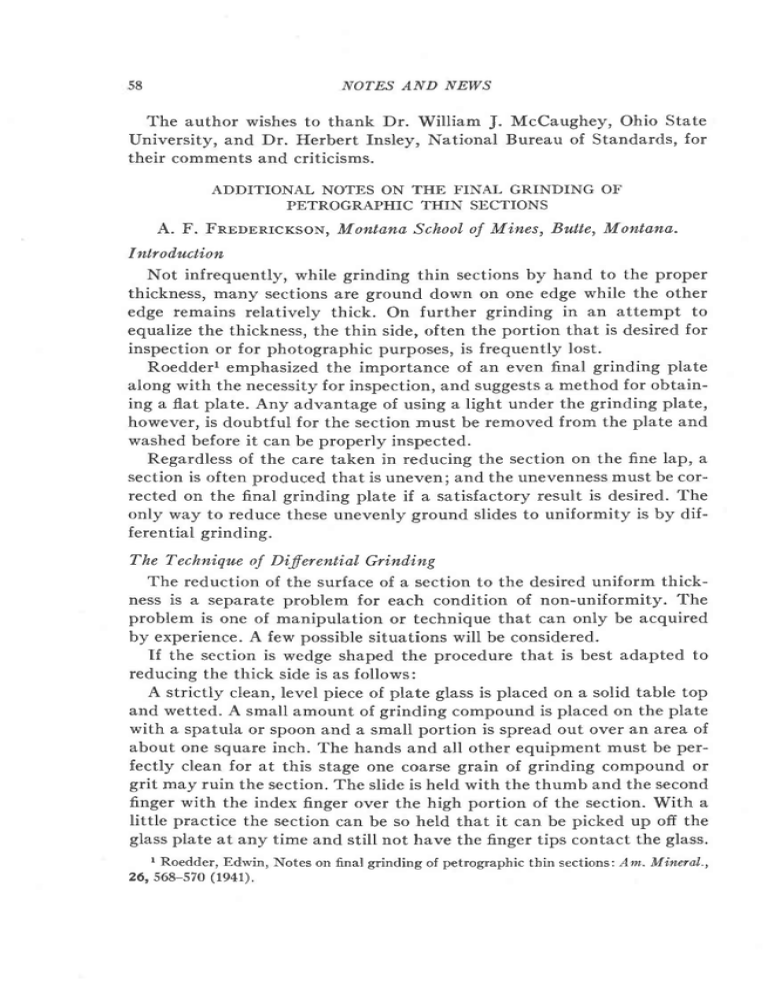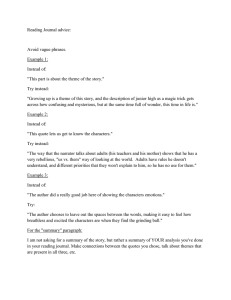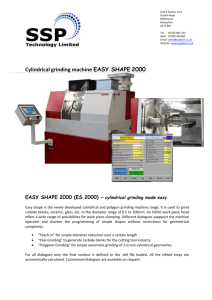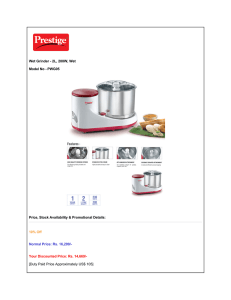58 The author wishes to thank Dr. William J. McCaughey, Ohio State
advertisement

58 NOTES AND NEWS The author wishes to thank Dr. William J. McCaughey, Ohio State University, and Dr. Herbert Insley, National Bureau of Standards, for their comments and criticisms. ADDITIONAL NOTBSON THE FINAL GRINDING OF PETROGRAPHICTHIN SECTIONS A. F. FnnnBRrcKSoN.Montana School of Mines, Butte, Montana. Inl.roiluction Not infrequently, while grinding thin sections by hand to the proper thickness, many sections are ground down on one edge while the other edge remains relatively thick. On further grinding in an attempt to equalize the thickness, the thin side, often the portion that is desired for inspection or for photographic purposes, is frequently lost. Roedderr emphasized the importance of an even final grinding plate along with the necessityfor inspection, and suggestsa method for obtaining a flat plate. Any advantage of using a light under the grinding plate, however, is doubtful for the section must be removed from the plate and washed before it can be properly inspected. Regardlessof the care taken in reducing the section on the fine lap, a section is often produced that is uneven; and the unevennessmust be corrected on the final grinding plate if a satisfactory result is desired. The only way to reduce these unevenly ground slides to uniformity is by differential grinding. The Techni.queof Diferential Grind,ing The reduction of the surface of a section to the desired uniform thickness is a separate problem for each condition of non-uniformity. The problem is one of manipulation or technique that can only be acquired by experience.A few possible situations will be considered. If the section is wedge shaped the procedure that is best adapted to reducing the thick side is as follows: A strictly clean, level piece of plate glass is placed on a solid table top and wetted. A small amount of grinding compound is placed on the plate with a spatula or spoon and a small portion is spread out over an area of about one squareinch. The hands and all other equipment must be perfectly clean for at this stage one coarse grain of grinding compound or grit may ruin the section. The slide is held with the thumb and the second finger with the index finger over the high portion of the section. With a little practice the section can be so held that it can be picked up ofi the glassplate at any time and still not have the finger tips contact the glass. 1 Roedder, Edwin, Notes on final grinding of petrographic tbin sections: Am. Mineral., 26,568-570 (1941). NOTES AND NEWS The holding of the slide, rather than just pressingon it with the fingers.is important if uniformity of grinding is to be attained. It is difficult to apply a uniform pressure with three fingers but it is relatively easy to apply the proper pressure when using only the index finger for pressing. The hand is held at all times in a relaxed attitude and the pressure applied is seldom more than the weight of the finger itself. With the slide held properly with the index finger over the thick side of the section, the slide is placed on the wetted square inch of grinding compound that has been spread as thinly as possible on the glass plate. The motion of grinding should be forward with the index finger bearing on the thick portion of the slide and thumb and secondfinger guiding and holding the other end of the slide to the plate without applying pressure. If the grinding were done on the return stroke the thick end would only be rounded off thus making the section more difficult to reduce to a uniform thickness. No rotary motion should be applied for this would produce a section rounded on the sidesand high in the middle. At frequent intervals the slide should be rinsed with water and examined under the microscope to seehow the grinding is progressing.If a slight scratch is felt or heard, grinding should be stopped immediately and the glass plate washed to remove all the grinding compound; the section should likewise receive the same treatment and should be examined to discover the causeof the scratch. A section that is of the proper thickness on the edgesbut high in the center presents a more difficult problem to reduce to a standard even thickness without losing a portion of the slide. The reduction of the high portion of the section can be accomplished as previously indicated except the index finger is now placed over the center of the high spotthe middle of the slide-and the other two fingers are held near the end of the slide. Again, the absenceof a rotary motion is imperative. If a section is uniformly ground but thick a rotary motion with the index finger held lightly on the center of the slide produces good results. Often, in spite of ordinary care, a piece of the section may break loose or a piece of grit may get under the slide and the section scratched or loosenedfrom the balsam. Careful and frequent inspection of the washed section immediately will show a seriesof colored rings or arcs. Grinding should be stopped if these arcs are observedand the section warmed, but not heated. The portion of the slide that is loose can be recementedinto place by pressureapplied with the flat head of a nail. When the section is very thin on one side and thick on the other, additional grinding according to the procedure mentioned above will sometimes remove the thin portion of the section in spite of care. A thin film of balsam spread on the thin end of the slide will permit the reduction of 60 PROCEEDINGS OF SOCIETIES the high end of the "wedge" and preserve the thin end. Too much balsam, however, should be avoided for a double wedge may be developed. Conclusion The author has ground many sections of difierent types of rocks and has produced hundreds of sections from cataclastic quartz, using the technique here described with very satisfactory results. A few timely remarks about the actual technique of the reduction of uneven sectionsto a standard thickness has been very useful in guiding those new in the art of grinding sections and, needlessto say, has saved many good sections that otherwise might have been lost. PROCEEDINGS OF SOCIETIES PHILADELPHIA MINERALOGICAL SOCIETY Acad,emgoJ Natural SciencesoJ Philad.el,phia, September4, 1941 Dr. Thomas presided with 52 members and visitors present. The program consisted of receiviri$ reports on summer trips. Mr. Trudell described an excursion to Maryland and Virginia with Messrs. Toothaker, Baldwin and Gordon, and exhibited barite from Frostbulg; pyrolusite from Crimora; rhodonite from near Louisa; pyrite, staurolite, tremolite, and gahnite from Mineral; and the usual minerals from Amelia. NIrs. Thomas described a trip to Grafton, N. H. (autunite, gummite and torbernite); North Groton (garnet), and Quebec. Mr. Gordon exhibited axinite from the Perkiomenville, Pa., quarry, a new locality for the mineral. Mr. Evans reported on a trip to Hiddenite and Spruce Pine, and Franklin, N. C. Dr. Lee exhibited aragonite and vivianite from Mullica Hill,N.J., and natrolite from Perkiomenville. Mr. Frankenfield found quartz crystals at Middleville, N. Y., nephelite and sodalite at Bancroft in Ontario, and apatite and sphene at Lake Clear. October2, 1941 Dr. Thomas presided with 74 members and visitors present. The following officers were elected for 1941-1942: President: Dr. W. Hersey Thomas; Vice-president: Charles R. Toothaker; Secretary: Forrest L. Lenker; Treasurer: Harry W. Trudell; Councillor: Harold Arndt. Mr. John Vanartsdalen was elected an honorary member. Mr. Charles R. Toothaker addressed the society on "Tubular calcite from Guanajuato." Mr. Gordon gave a Kodochrome illustrated talk on "Collectins Minerals in the Trans-Pecos of Texas." Fonnnsr L. LnNxnt, Secretary BOOK REVIEW NEVADA'S COMMON MINER-ALS by VrNcnNr P. GreNlrnr,r,.q.. University of Nevada Bulletin. Geoiogy and Mining Series,No. 36. 110 pages. 1941. Price 50 cents. This bulletin is a revision and expansion of a previous work by Grawe (University of Nevada Bu11.,vol. 22,No. 7,1928).It is designedprimarilyfor the prospector and layman interested in the minerals of Nevada. Part 1 deals with the origin, occurrence, and association of minerals; Part 2 treats of the general characteristics of minerals; and Part 3 records the description of 125 minerals commonly found in the State with tables for their determination based on physical properties. The concluding chapter (Part 4) lists (without description) 400 mineral species that up to the present have been found in Nevada. w. F. H.


